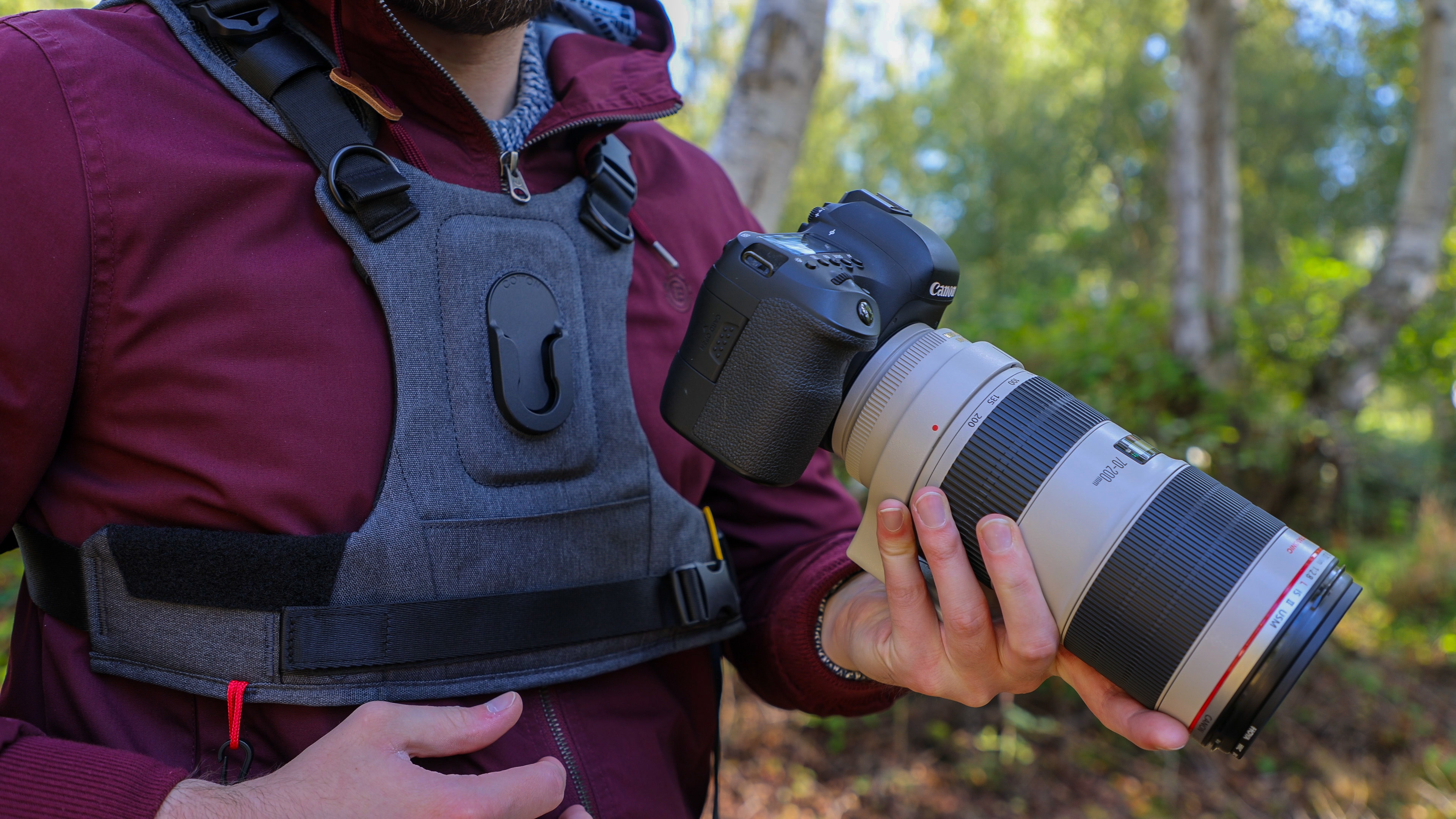
Designed for the active photographer, Cotton Carrier’s CCS G3 harness supports a camera with a long lens attached to its large chest plate on the front, bringing it within easy reach for quick shooting and also freeing up your hands when you’re not taking photos.
The camera harness is made in Vietnam and assembled in Canada. It arrived in eco-friendly cardboard packaging and Cotton Carrier is also a member of 1% For The Planet, an organization whose members contribute at least 1% of sales to the preservation of restoration of the natural environment, so it’s good to know you’re supporting an ethical business if these are causes you care deeply about.
I recently got hold of one and put it through its paces to find out if this is a camera harness you should buy.
Specifications
Size: One-size fits all
Colours: Charcoal Grey or Realtree Xtra Camo
Rain cover: Yes
Material: Kodra synthetic canvas, impact-resistant fiberglass, aluminum
Webbing material: Nylon
Weight: 0.97 lb / 441g
Features
I recently reviewed the BlackRapid Double Breathe and BlackRapid Blackline II harnesses which allow two cameras to hang down by your waist on straps, the Cotton Carrier G3 is a different beast altogether, as it predominantly centers around one large camera attachment point on a chest plate that sits central on the front of the harness.
It's worth noting that while I got hold of the G3 Harness-1, there is a more expensive G3 Harness-2 ($179) available which comes with a removable camera holster to secure an additional camera to the waistband, handy for scenarios like weddings where you need two cameras loaded up with different lenses.
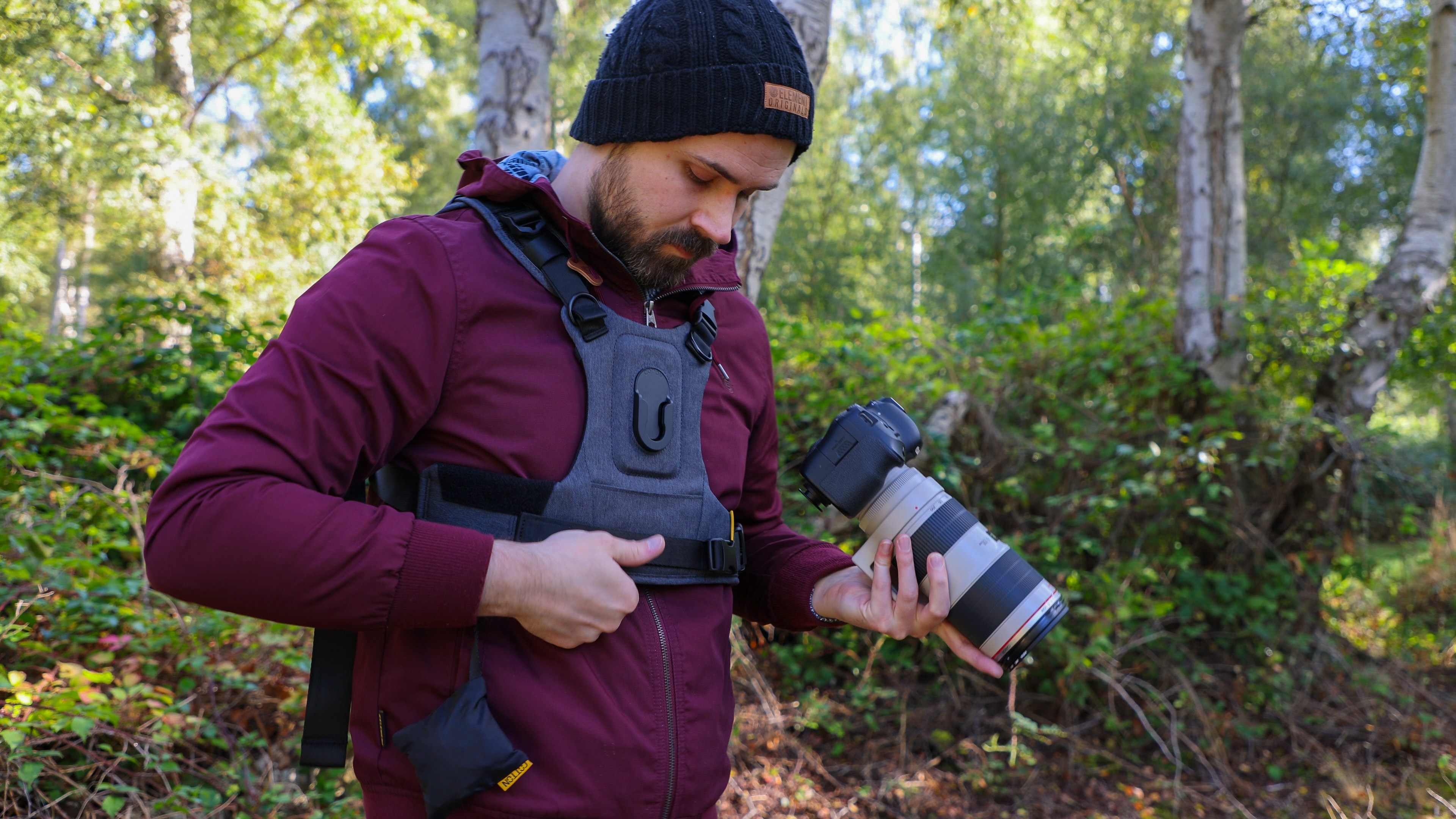
The harness uses four straps to fit around your torso, two going around the upper waist / lower chest, and two going over each of your shoulders. They’re all adjustable too with Cotton Carrier claiming it should be a good fit for chests measuring between 26-57”. The left waist and left shoulder straps also have quick-release buckles which make it easier to get in and out of when you’ve cinched all of the straps tight to your torso.
Joining all four straps together on the back of the harness is a large back panel which has a little bit of padding around the shoulders and back, it also features a plastic mesh design which makes it breathable. There are also stash pockets around the harness: a large netted pocket on the back panel, a small pocket on the front at the bottom of the chest plate, and a small hidden netted pocket on the inside of the chest plate.
The top shoulder straps are quite long and spare material overhangs into the stash space on the back panel – this design also makes them quite fiddly to adjust. The two shoulder straps aren't stitched on, instead, they use velcro so you can extend the shoulder pad length and still benefit from padding.
At first, we were dubious to trust our heavy setup to two velcro connections, however, due to physics the harness essentially turns your shoulder into a pulley, with the weight of your camera pressing on your shoulder rather than on the velcro connections on the back. To test these connections thoroughly I strapped a 6.3Kg dumbbell to the front chest plate which is a similar weight to a DSLR and 400mm f/2.8 lens. When the harness was tightened up properly to my torso the velcro straps didn't show any signs of coming undone, though it was a concern in the back of my mind nonetheless and I was always on edge, wondering if it would ever give out.
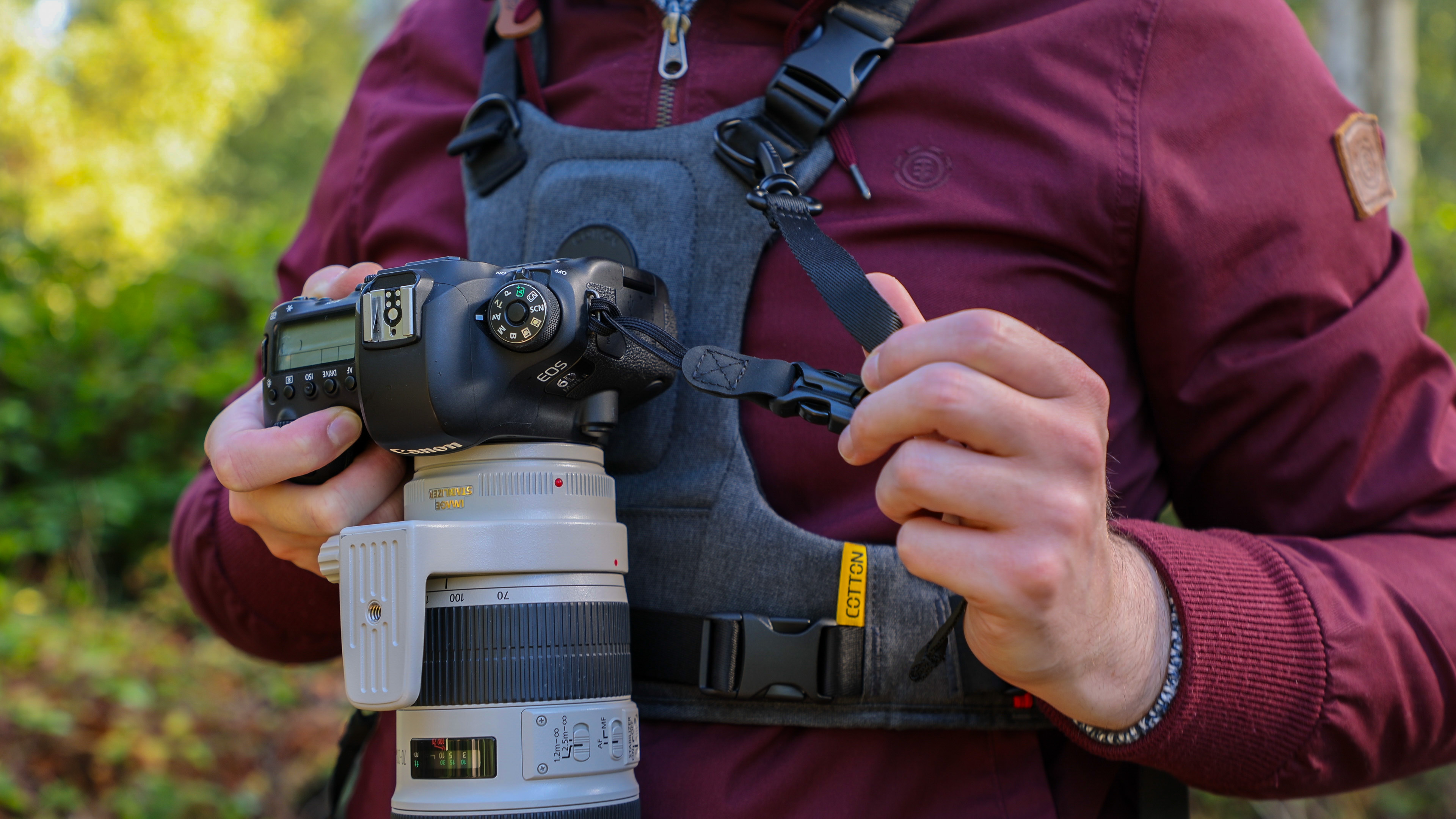
Also in the box, you’ll find a security tether that can be clipped onto the harness and the corresponding end attached to the strap lug on your camera which acts as a failsafe should you drop your camera when it’s not docked to the chest plate. This strap also has a buckle so you can remove it completely if you need to shoot at an awkward high or low angle.

There’s a rain shell that can be attached to a red loop at the bottom of the harness so it’s always within reach and it packs neatly away into a small bag when not in use. When opened the rain cover provides up to 10” of clearance, so will work with even fairly hefty lenses, and helps keep the rain off your camera when it’s docked to the chest plate. This is handy for photographers who don’t have time to put their kit away in a downpour, or who want to continue shooting in the rain.
The camera mounting system uses Cotton Carrier’s patented Twist & Lock design which is a great way to quickly dock or undock your camera (with lens attached) using just one hand to twist and rotate it in or out of the mount on the front chest plate.
The chest plate on the front of the harness has a large 65x120mm plastic rectangle in the center, with a plastic clip for your camera to dock into. How exactly it docks is by attaching the provided CCS ‘hub’ quick-release plate to the base of your camera. This hub piece is aluminum and comes with a 3mm thick rubber washer, a bolt is provided which needs to be attached to your camera with a hex key – this is a little annoying as many quick-release plates from other manufacturers can be tightened by a coin, screwdriver or fold-away handle so if you misplace your hew tool you're a bit out of luck.
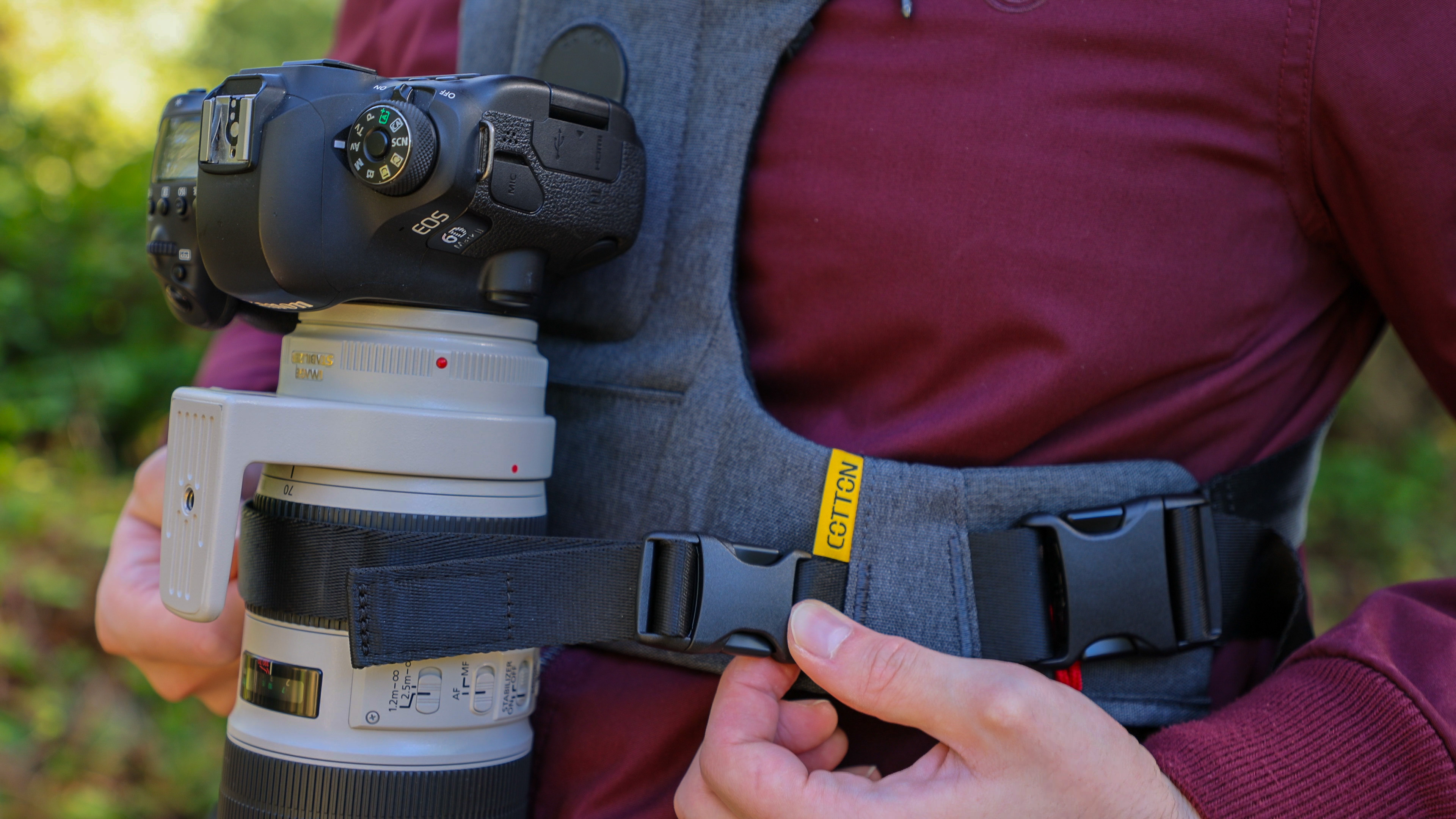
Once your camera is docked to the chest place you can use the lens stabilizer strap located at the bottom of the front chest plate to strap in long lenses and stop them from moving around too much when you’re on the move. The stabilizer strap also features a ‘quick clip’ to help you strap it in or unlock it quickly once you’ve adjusted it to the right length to suit your attached lens.
Performance
Despite the company being called Cotton Carrier, the G3 doesn’t have a shred of cotton in sight. The G3 instead opts for materials such as Kodra synthetic canvas, impact-resistant fiberglass, nylon webbing, polyethylene foam, plastic, and an aluminum quick-release CCS hub.

At the core of the G3 is the CCS aluminum hub which bolts onto your camera’s tripod mount and then allows your camera to be twisted and locked quickly onto the harness, this system is also patented by Cotton Carrier. While it does make it really quick and easy to dock or undock your camera and start shooting, the downside is that it requires a hex key to attach the CCS hub, so if you forget or misplace your hex wrench you’re out of luck!
The plastic-on-metal mount is also prone to creaking when you're on the move, though strapping longer lenses down with the stabilizer strap goes a long way to quieten it. You can also stop it from creaking by putting your hand on the camera to put tension on the mount, but this kind of defeats the whole hands-free operation.
The CCS hub features a female port on its underside allowing tripod QR plates to be attached, so fortunately you don’t have to remove the whole CCS hub to use a tripod, which would be quite a faff. One downside of the CCS hub is that it’s made from three parts which can all get separated quite easily: the aluminum hub, rubber washer, and bolt for the tripod mount. The G3 doesn’t come with a spare so you’ll need to purchase a new one for $29 or £20 should you lose any parts of yours - ouch!
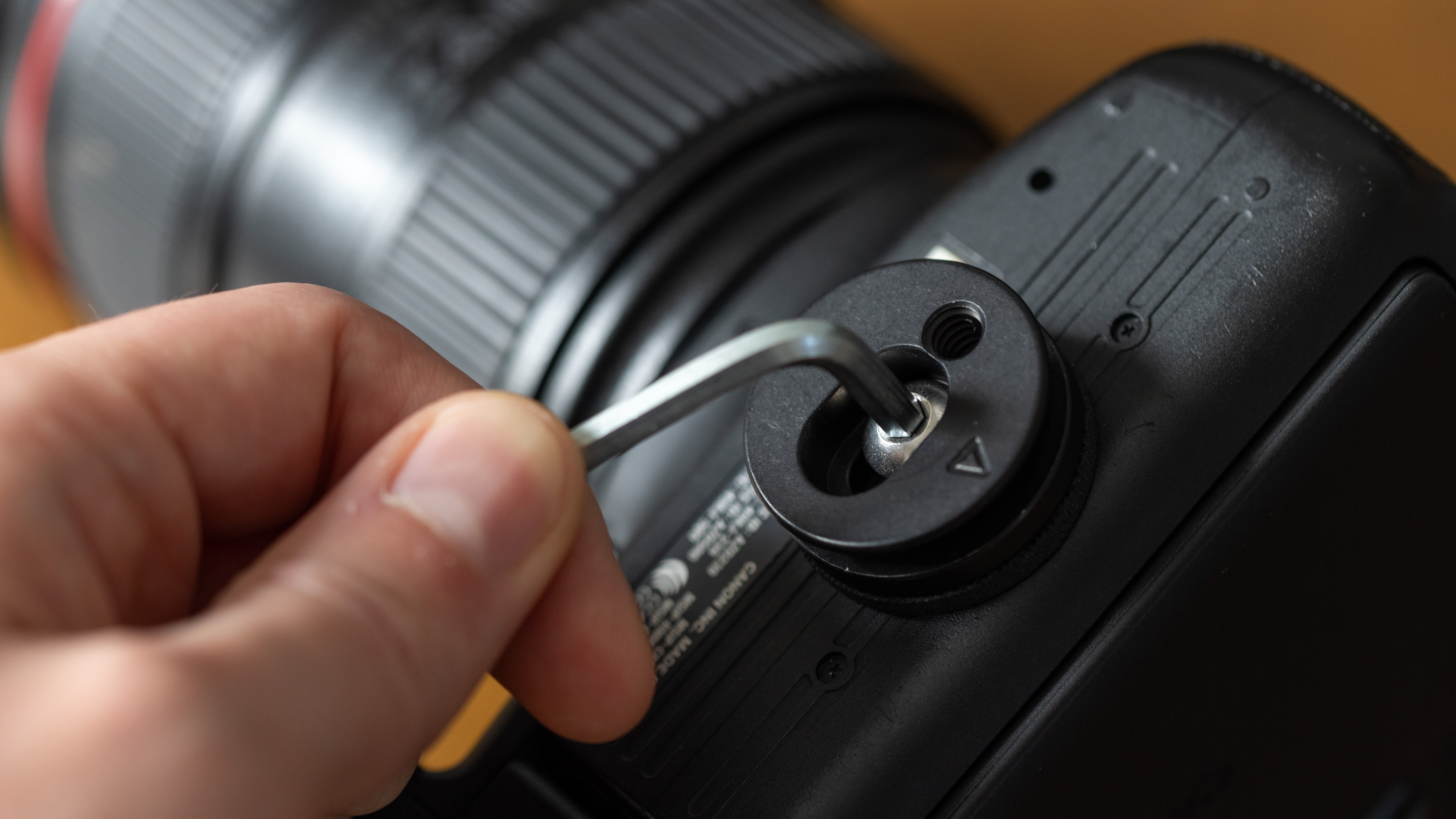
The padding around the chest and straps is quite thin and the mesh on the back panel is a hard plastic mesh. The Kodra synthetic canvas is also quite tough and rubbed up against my neck when the harness was loaded up with a heavy setup like my Canon EOS 6D Mark II DSLR and 70-200mm f/2.8 lens which combined weighs 2.6 kg.
It was much more comfortable wearing the G3 over the top of a coat with a hood to stop the back panel from coming into contact with my neck. One advantage of the padding on the G3 harness being quite thin is that it easily fits underneath a jacket, handy if you want to put your coat around your camera in the harness to protect it from the rain, or to keep prying eyes off it when you’re photographing cities.
Cotton Carrier says there is no maximum weight for the G3, so it can be loaded up with everything from kit lenses to larger telephotos which makes it ideal for hikers using a camera with one lens attached, or wildlife photographers going out with just one long lens.
The CCS hub is aluminum and is the mount connection to the base of your camera, though the female connection on the harness is plastic, so we did have concerns that the metal might wear down the plastic over time. It’s also worth noting that it doesn't work nearly as well with cameras that have a built-in grip, or battery grip attached, as the extra distance from your torso creates extra space for your lens to bounce around in.
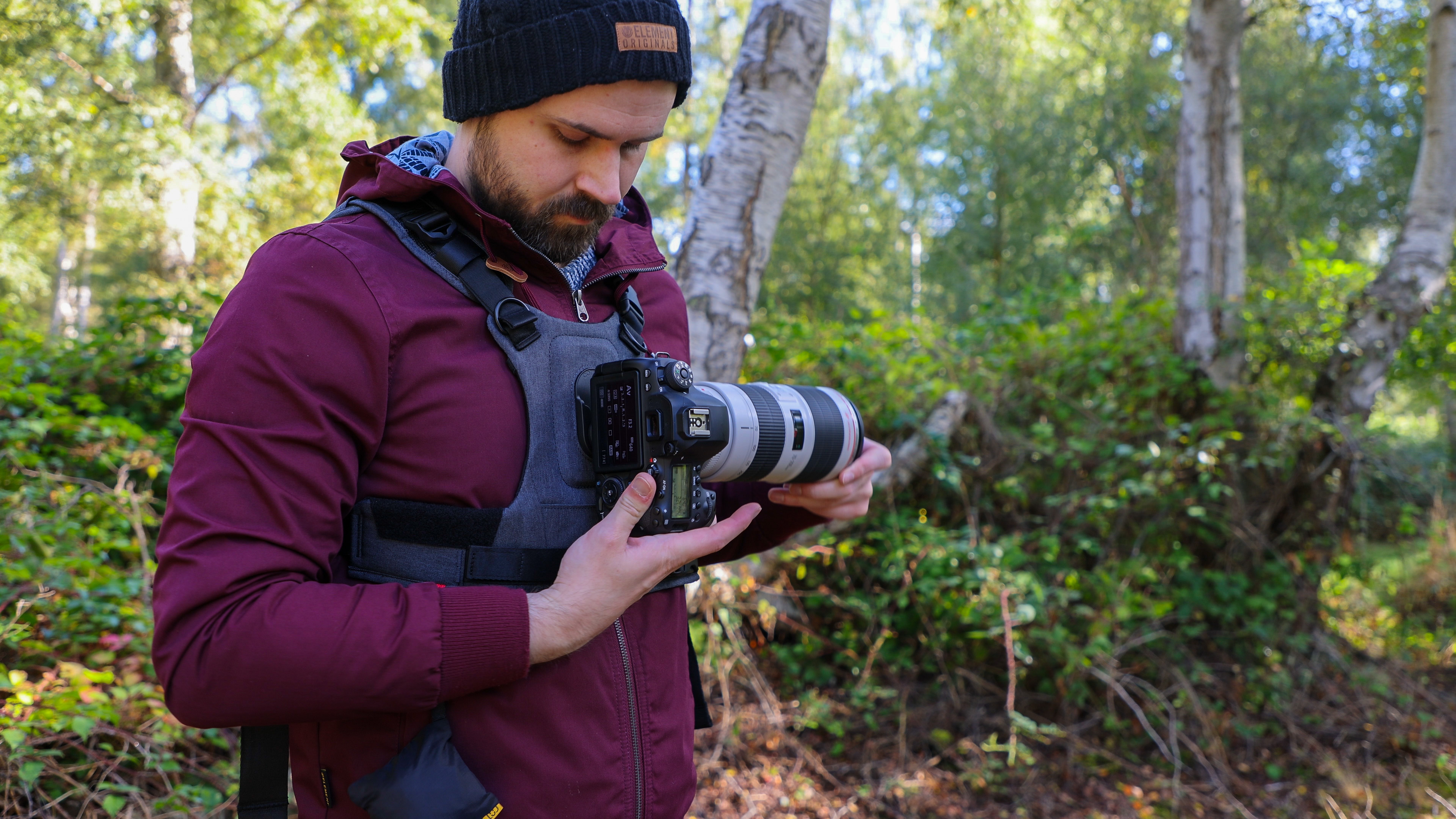
Sticking with the CCS hub, the patented Twist & Lock mechanism does a good job of keeping the camera secured to the harness, though it has to be rotated by 90º to dock or undock it. While we liked that this meant it could be operated with one hand with smaller optics, it can be a bit of a workout to twist and rotate cameras loaded up with larger and heavier lenses. The direction of the hub can also accidentally become twisted out of alignment and it can then be frustrating to try and figure out which way you need to turn the camera to get it facing the right way to dock or undock.
One slightly annoying issue is that there aren't any clasps on the waist straps to tuck away any additional side strap material so if after fitting it to your chest you end up with an excess you just have to deal with the straps dangling down.
We weren’t sent the CCS G3 Wanderer Side Holster which turns the G3 harness into a two-camera system, though multiple users left negative reviews online saying that it’s only held on with velcro and that it wasn’t the most secure system.
Verdict
The Cotton Carrier CCS G3 harness solves many problems for photographers who use a camera with a single lens attached, such as those on a nature walk or wildlife photographers carrying a camera with a long lens to location. The G3 frees up your hands and transfers the weight onto your shoulders which improves comfort over handholding big tele lenses, while also keeping it within reach so you can quickly undock it and get shooting should a moment present itself.
The downsides are the plastic on metal mounting system can squeak a little and if you load it up with a very heavy setup it can pull the harness forward so the course canvas-like material rubs up against your neck unless you wear the harness over a coat which can act as a barrier and also add extra padding.
For lighter setups such as a camera with a kit lens, we preferred the more affordable Cotton Carrier Skout G2, though the G3 is better suited to bigger telephoto lenses. A concern is that the back straps are only held on by velcro and seemed like a bit of a weak point, though despite loading it up with heavy weights in our tests we couldn't bring the G3 to failure.
Should you buy the Cotton Carrier CCS G3?
✅ Buy this if...
- You want a harness so that you can be hands-free
- You’re looking for a more comfortable solution when hiking with big lenses
🚫 Don't buy this if...
- You want to wear two cameras by your hips as the BlackRapid Blackline II is a better option
- You’re looking for more substantial padding and comfort across the shoulders







